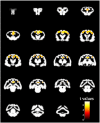Age-related brain atrophy in cats without apparent neurological and behavioral signs using voxel-based morphometry
- PMID: 36504872
- PMCID: PMC9729775
- DOI: 10.3389/fvets.2022.1071002
Age-related brain atrophy in cats without apparent neurological and behavioral signs using voxel-based morphometry
Abstract
Introduction: Brain atrophy is observed with aging and may cause cognitive decline or dysfunction. Aging cats may demonstrate behavioral changes related to cognitive dysfunction. In the clinical veterinary field, although the conventional region of interest method by manual or semiauto tracing on magnetic resonance imaging is used to detect atrophy of regional structures, such as the hippocampus, it is difficult to assess atrophy globally. Voxel-based morphometry (VBM) has been developed to detect global and regional abnormalities in humans. The purpose of the present study investigates whether the feline brain volume decreases with aging using VBM analysis.
Materials: A total of 65 cats, aged 17-200 months, without apparent neurological and behavioral signs were included in the statistical analysis.
Results: We observed that the gray matter in the bilateral parietal lobes was decreased significantly with aging. The regions that showed decreased volume included the right postcruciate, cingulate gyrus, rostral suprasylvian/ectosylvian gyri, and the left postcruciate gyrus. No significant reduction in white matter was observed. Together, our results show that age-related brain atrophy can be detected using VBM analysis.
Discussion: The age-related atrophy of the parietal cortex may not cause neurological and behavioral signs in cats. Therefore, veterinarians should consider age when assessing the relation between morphometric and functional abnormalities of the parietal cortex in cats.
Keywords: MRI; VBM; aging; brain atrophy; feline; parietal cortex.
Copyright © 2022 Hamamoto, Yu, Asada, Mizuno and Hasegawa.
Conflict of interest statement
The authors declare that the research was conducted in the absence of any commercial or financial relationships that could be construed as a potential conflict of interest.
Figures




Similar articles
-
Application of an automated voxel-based morphometry technique to assess regional gray and white matter brain atrophy in a canine model of aging.Neuroimage. 2006 Jan 1;29(1):234-44. doi: 10.1016/j.neuroimage.2005.07.043. Epub 2005 Nov 7. Neuroimage. 2006. PMID: 16275022
-
[The relationship between simple numerical function and gray matter volume in normal brain aging].Zhonghua Yi Xue Za Zhi. 2019 Jan 29;99(5):370-374. doi: 10.3760/cma.j.issn.0376-2491.2019.05.010. Zhonghua Yi Xue Za Zhi. 2019. PMID: 30772979 Chinese.
-
White matter atrophy in brain of neuromyelitis optica: a voxel-based morphometry study.Acta Radiol. 2014 Jun;55(5):589-93. doi: 10.1177/0284185113501815. Epub 2013 Aug 21. Acta Radiol. 2014. PMID: 23966367
-
Gray matter atrophy in narcolepsy: An activation likelihood estimation meta-analysis.Neurosci Biobehav Rev. 2015 Dec;59:53-63. doi: 10.1016/j.neubiorev.2015.03.009. Epub 2015 Mar 28. Neurosci Biobehav Rev. 2015. PMID: 25825285 Review.
-
Voxelwise meta-analysis of gray matter anomalies in Parkinson variant of multiple system atrophy and Parkinson's disease using anatomic likelihood estimation.Neurosci Lett. 2015 Feb 5;587:79-86. doi: 10.1016/j.neulet.2014.12.007. Epub 2014 Dec 5. Neurosci Lett. 2015. PMID: 25484255
Cited by
-
Preliminary Findings on the Morphometric Characteristics of the Olfactory Bulb in the Cat.Animals (Basel). 2024 Dec 12;14(24):3590. doi: 10.3390/ani14243590. Animals (Basel). 2024. PMID: 39765495 Free PMC article.
References
LinkOut - more resources
Full Text Sources
Miscellaneous

